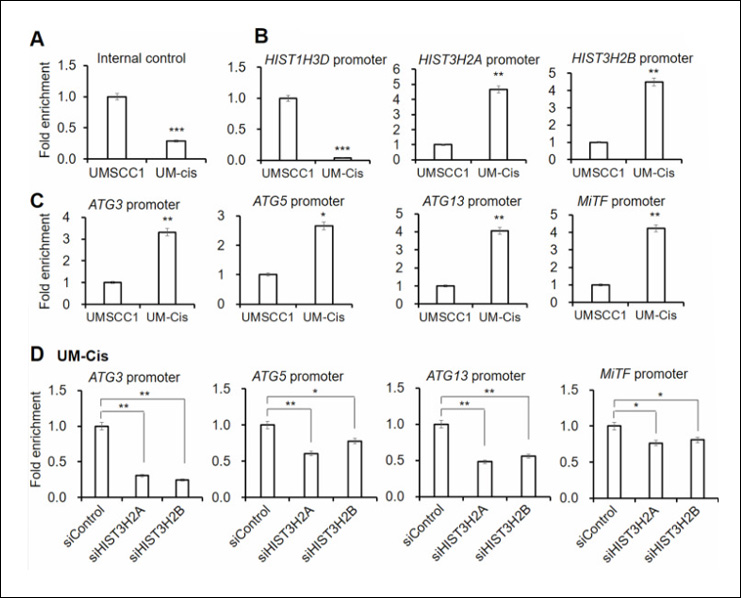Afroze N et. al. (April 2025). Kaempferol Targets Global Epigenetic Modifiers to Impedes Growth and Migratory Ability of HeLa Cells J Cell Mol Med. 29(7):e70498.
This study investigates the epigenetic effects of kaempferol on HeLa cells, focusing on its impact on chromatin modifications and tumor suppressor gene (TSG) expression. Kaempferol treatment reduced the activity of DNMTs and HDACs, leading to TSG promoter hypomethylation and increased gene expression, which correlated with inhibited cell growth and migration. These findings suggest that kaempferol acts as an epigenetic modifier with potential anti-cancer properties.
Products Used: EpiQuik Nuclear Extraction Kit
Veschi V et. al. (March 2025). C1Q+ TPP1+ macrophages promote colon cancer progression through SETD8-driven p53 methylation Mol Cancer. 24(1):102.
This study examines how C1Q+ TPP1+ tumor-associated macrophages (TAMs) promote colon cancer progression by inducing SETD8-mediated p53 methylation, leading to its functional inactivation. Elevated p53K382me1 levels were found in colorectal cancer stem cells and TAMs, correlating with poor patient survival. Targeting SETD8 pharmacologically or genetically, especially in combination with IL-6 receptor inhibition, impaired tumor growth and metastasis, highlighting a potential therapeutic strategy for colorectal cancer.
Products Used: EpiQuik Total Histone Extraction Kit
Du X et. al. (March 2025). Long-term exposure to PM2.5 exacerbates dopaminergic neuronal loss through CpG hypermethylation induced down-regulation of PINK1 and DJ-1 genes Sci Rep. 15(1):10778.
This study explores how long-term exposure to PM2.5 exacerbates dopaminergic neuron loss in a Parkinson’s disease model through DNA methylation-driven gene suppression. PM2.5 exposure increased CpG hypermethylation in the promoters of PINK1 and DJ-1, leading to their downregulation and worsening neurodegeneration. These findings highlight the epigenetic impact of air pollution on Parkinson’s disease progression.
Products Used: Methylamp DNA Modification Kit
Yang X et. al. (March 2025). MRI-based habitat imaging predicts high-risk molecular subtypes and early risk assessment of lower-grade gliomas Cancer Imaging. 25(1):43.
This study investigates the use of MRI-based habitat imaging to predict high-risk molecular subtypes and assess early prognosis in lower-grade gliomas (LrGGs). By analyzing MRI sequences and key molecular markers, the researchers developed predictive models, with the habitat-based model achieving high accuracy in identifying high-risk subtypes. The findings highlight the potential of non-invasive imaging for early risk assessment and improved clinical management of LrGGs.
Products Used: BisulFlash DNA Modification Kit
Luo Q et. al. (March 2025). TLR9 in satellite glial cells promotes paclitaxel-induced neuropathic pain by reducing Kir4.1 transcription through histone methylation activation Brain Behav Immun.
This study examines the role of Toll-like receptor 9 (TLR9) in satellite glial cells in promoting paclitaxel-induced neuropathic pain through epigenetic regulation. TLR9 activation leads to histone methylation-mediated suppression of Kir4.1, a key potassium channel that regulates neuronal excitability, contributing to heightened pain sensitivity. Targeting TLR9 and its downstream histone modifications may offer new therapeutic strategies for managing chemotherapy-induced neuropathic pain.
Products Used: EpiQuik Tissue Chromatin Immunoprecipitation (ChIP) Kit
Yang X et. al. (March 2025). HB52-PUT2 Module-Mediated Polyamine Shoot-to-Root Movement Regulates Salt Stress Tolerance in Tomato Plant Cell Environ.
This study explores the role of the HB52-PUT2 module in regulating salt stress tolerance in tomato through polyamine transport. Disruption of PUT2, which mediates polyamine shoot-to-root movement, leads to increased salt sensitivity, while HB52 enhances PUT2 expression and promotes Na⁺ efflux. These findings reveal a transcriptional regulatory network that facilitates polyamine redistribution, contributing to improved salt stress resilience in tomato plants.
Products Used: EpiQuik Plant ChIP Kit
Wu L et. al. (March 2025). Edaravone inhibits neuronal ferroptosis and alleviates acute Central nervous system injury induced by diquat via enhancement of METTL14-mediated m6A methylation of Aldh1l1 Wu L et. al. (March 2025).
This study investigates how edaravone (Eda) protects against acute central nervous system injury caused by diquat exposure. Eda enhances METTL14-mediated m6A methylation of Aldh1l1, which suppresses neuronal ferroptosis and mitophagy, reducing oxidative stress, inflammation, and apoptosis. These findings highlight a novel neuroprotective mechanism of Eda involving epitranscriptomic regulation.
Products Used: EpiQuik m6A RNA Methylation Quantification Kit (Colorimetric)




 Cart (0)
Cart (0)













